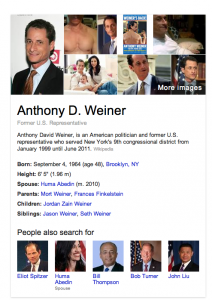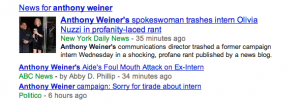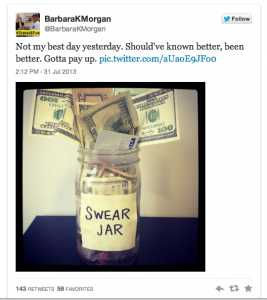OnLine Reputation Management was a topic this week in the graduate class I teach at NYU. It can be a complex subject in a world where the first touch points when encountering a brand, a business or a person are the results of a Google search. I didn’t plan on the topic coinciding with a real life example of a brand gone astray – but then I didn’t plan on being back blogging after just one day of rest from my 30-day blogging marathon.
You see – I just couldn’t help myself! Watching the Anthony Weiner for Mayor debacle provides such a great illustration for a lesson in managing reputations online.
We’ll start with the Google search.
You’ll notice 656 MILLION results at this writing and that is just for Anthony Weiner. Google also suggests these similar combinations :
Odd to see mayor and penis separated only by twitter – but somehow poetic.
The idea behind managing an online reputation is to try and take control of what one finds when searching you or your brand. If done right you can exert influence over that nice piece of real estate Google offers – for FREE – in the side bar.
What shows up in the search results is based on those mysterious Google algorithms used as the famous Googlebot trolls the web in search of treasure. This means that managing an online reputation can be a really difficult job when you are posting pictures of your bare chest (among other body parts) on highly used social networks.
Most experts on the topic of online reputation management will suggest a brand have two teams working this.
Team One is ongoing – actively monitoring what is being said about you, engaging in social media, and working to create content that accurately depicts the message you want the brand to send. This is the group that has the opportunity to control what those first links are that will appear when a search is performed. Part of their job is to minimize anything unsavory that has the potential to go viral.
Here are the first links that appear when Anthony Weiner is typed in on July 31.
Mmm. Someone is not doing their job.
Enter Team Two.
Team Two is the crisis team. A crisis team ideally should represent these four areas:
-Public Relations
-Legal
-Human Resources
-Executive Management
This is the group that has brainstormed all the possible scenarios of what can and could go wrong and created a plan – ready to go – if needed. Collectively this group works to minimize any damages that are the result of a misinterpretation of a message sent or an unseen and unaccounted meteor from outer space landing in your office that you now have to deal with- like reports of sexting pictures of yourself under a pseudonym.
Team Two should be your top notch people, the ones entrusted to make it all go away as quickly and with as little mess as possible. No one in this group would think to add fuel to the fire much less think to call interns “sluts” and then issue an apology via a twitter pic to ease the damage.
Or would they? The above tweet is from Weiner’s communications director after her expletive filled rant.
Managing a reputation – online – can be an overwhelming job in a 24/7 digital world where there are lots of things that are beyond our control.
Which leaves us only to work with the things we can control.
-Like thinking things through.
-Using our common sense.
-Communicating internally.
-Having a sense of right and wrong.
-Understanding that sometimes the mess can get so big, there is no recourse but to take the brand off the market, out of sight and rethink what direction you want to go in the future. (Anthony Weiner – I really hope you are reading this)
It might sound like managing it all is a monumental task.
But it’s really not.
Not if you start with this suggestion from online reputation management expert and author Lori Randall Stradtman –
“… only post things you wouldn’t mind seeing on a billboard.”
Because you never know when you might see it there.








Leave a Reply